The impact of COVID on the world of work has been drastic, rapidly changing the landscape in ways none of us could have imagined.
It destroyed millions of jobs, with the International Labor Organization (ILO) predicting that the deficit in the number of hours worked globally in 2022 would be the equivalent to 26 million full time jobs.
Now those figures have doubled to 52 million full time jobs. With a slow recovery ahead, the ILO has also predicted that the global unemployment rate will remain above pre-pandemic levels until at least the end of 2023.
But on a more positive note, the pandemic also rocket-fuelled innovation, as technology quickly evolved to ensure organizations could continue to operate while the workforce shifted to working remotely almost overnight.
This is no novelty, or temporary situation. Hybrid working is now the next phase of workplace culture and the prevailing way we operate. It is an ongoing evolution, and the global workforce is learning to adapt to the benefits and challenges.
This comprehensive guide is aimed at equipping every organization with the tools they need to navigate this evolving landscape, by exploring key strategies to optimize their own version of the hybrid workplace and ensure success now and well into the future.
Introduction
“The biggest business priorities driving Tech Investments are innovation, improving customer experience (CX) and enhancing employee productivity and experience”.
Audrey William, Principal Advisor, Ecosystm
Hybrid work is a big departure from the traditional pre-COVID work model but is now firmly embedded in our workplace vernacular and practices.
Even though it has become the normal way to work, there is still no roadmap or manual for a universal hybrid workplace. Every organization, every industry, and every workforce has different requirements, and their own definition of success. However, there are vital considerations that all organizations need to address:
- How will IT and UC teams keep up with constantly evolving workplace requirements?
- How will business leaders address the needs of employees and customers/clients?
- How will CIOs ensure the performance of the systems they have in place?
Organizations are getting better at establishing flexible working situations, as well as tackling the logistics of enabling and maintaining a safe working environment.
In many cases, this has involved an overhaul, or even a complete replacement, of legacy infrastructures. But the benefits and rewards of establishing a hybrid workplace are proving to outweigh the challenges, costs, and efforts.
The foundation of a successful hybrid workplace is to equip all users with feature-rich, intuitive collaboration tools to message, meet, voice and video-call, share content, and communicate from any space or place, on any device, at any time.
By addressing the strategies in this guide, organizations large and small can achieve success, and thrive in a hybrid working world.
Let’s delve into how the foundations can be implemented and kept rock-solid, while remaining flexible enough to harness new ways to bring people together.
Download the Ultimate Guide to Future-Proofing the Hybrid Workplace as a PDF

Download the Ultimate Guide to Future-Proofing the Hybrid Workplace as a PDF
Innovation: Making the hybrid workplace better
Hybrid work is not a one-size-fits-all undertaking, but at the same time, it’s not a new concept. For years, organizations such as professional services, software companies, and creative service companies have adopted a hybrid model with measured success.
The challenge in today’s workplace is to ensure a seamless strategy where those who work from the office and those who work remotely can be well-equipped to take advantage of all avenues of collaboration at any time. This includes keeping on top of evolving technology and staying flexible enough to change business models if needed.
Let’s look at why innovation in the workplace is a critical factor in making the hybrid workplace work better.
Innovation is driven by three key factors:
- Flexibility and agility
- Infrastructure
- Supporting rapid digital transformation
“Agility is the ability of an organization to renew itself, and adapt quickly to change in a rapidly evolving, ambiguous and turbulent environment.”
McKinsey
Flexibility and agility
According to McKinsey, agility can be defined as ‘the ability of an organization to renew itself, and adapt quickly to change in a rapidly evolving, ambiguous and turbulent environment.’
The key for enterprises to achieve business agility is a willingness to redesign organizational structure, change operating models, create new capabilities, and alter how their business works.
The old business model or ‘machine’ structure simply won’t work in today’s working world. Those businesses still clinging to a top-down hierarchy, silos, bureaucracies, and legacy approaches to every tier of operation will be left behind.
Today, agility depends on a company's flexibility, with leadership that shows direction, enables proactive policies, motivates, and builds its teams around accountability.
Benefits of an agile business
-
Enabling an organization to adapt to any situation
-
Responding quickly to changes
-
Finding and eliminating problems and errors
-
The ability to adjust to sudden market changes or crises
Infrastructure
In the hybrid workplace, employees are dispersed in various locations, and collaboration is often asynchronous. Digital communication is the only way to ensure business continuity and it has become a solid part of our working life. The way we do things these days is:
- Video conferencing or chatting on platforms like Microsoft Teams, Webex, Zoom and other communication vehicles
- Collaborating on a shared document
- Brainstorming with your team on a virtual whiteboard
- Instant messaging (IM) or chat
-
Email (used most effectively alongside these other methods)
Working digitally underscores the importance of a reliable network. A poorly maintained network can not only slow things down but compromise valuable data. If those organizations that have adopted hybrid working models have put the right infrastructures in place, they’ll be far better equipped to deal with the challenges.
How to set up your infrastructure for hybrid workplace success
Find out
Find out what’s working and what isn’t by auditing your current systems. Growth and transformation are good, but they can also expose your organization to security breaches as employees rely on virtual workflows, networks and collaboration tools to achieve their goals.
Consider
Consider business automation to streamline workflows. Robotic Process Automation (RPA) uses tools, often called bots, to manage applications, gather and analyze data, communicate between systems, and trigger specific actions. This can achieve significant time and cost savings while freeing up employees to focus on higher-value tasks.
Evaluate
Evaluate your workplace hardware by reassessing what devices you need and what you can do without or upgrade.
Assess
Assess whether a hybrid cloud solution is a good option. A hybrid cloud is the integration of a public cloud with a private cloud or on-premises resources. The idea is to take advantage of different environment types depending on your requirements. (More on that later).
Supporting rapid digital transformation
Digital transformation is a necessity if companies are to sustain growth and remain fully operational in the future. New employees are onboarded virtually, customers are being won and serviced remotely, and ever-emerging new technologies are being implemented as part of then new hybrid work model.
Re-shaping business culture
Successful digital transformation also requires a cultural re-shape, an employee support framework and a new leadership style. Having clear rules and best practice guidelines for remote working and virtual meetings is just as important as having the right technology infrastructure in place.
According to Gartner, 46% of businesses cite culture as the most significant barrier to scaling digital transformation. Your entire organization must be aligned, engaged and on board with technology and changing business models to reap the rewards of hybrid working.
Ways to do this include:
- Carefully appointing champions for change
- Regularly communicating the company vision, and purpose for transformation
- Keeping employees updated on progress
- Delivering ongoing training collateral on new communication systems
The cloud initiative
As we’ve already established, the key to creating a successful hybrid workplace is enabling flexibility. The cloud has proven itself in recent years to offer this flexibility, not to mention delivering up-to-date security features.
But the overriding benefit of the different cloud models is ease of scalability. With virtually all end-devices now connected to the internet and employees often equipped with company-provided devices or their own personal endpoints, the cloud enables hybrid work.
The need to adapt and change direction quickly is a core principle of a digital business, and this is where the benefits of hybrid cloud shine brightest.
Innovating the physical office
The hybrid work model that has emerged since the onset of the pandemic has settled into something of a norm. But the office hasn’t lost its importance, in fact, recent research has discovered that in 2022, 75% of employees want to be back in the office in some capacity, either full time or when the need arises.
Survey Results HighlightsThoughts on remote working |
|
| 25% | Want to work remotely for the rest of their career |
| 51% | Want to choose their work location — whether home, office or a shared space |
| 14% | Want to work from the office on fixed days |
| 10% | Want to work from the office all the time |
| Source: Ecosystm Voice of the Employee Study 2022 | |
In fact, a PWC survey of over 100 executives and 1,300 employees revealed that 87% of respondents believe the physical office is necessary for collaboration and building relationships with other team members.
As a result, organizations are adapting their offices, with a focus on driving a seamless user experience, using the right technology for each individual setting. Here’s what’s happening in the quest to make the ‘new’ office space fit for purpose:
- The use of huddle rooms is increasing, and old-style cubicles are being redesigned. There will also be more open spaces for employees to come together in informal work settings.
- The high usage of video within rooms and from home will require ‘smart galleries’, giving participants equal importance, irrespective of location. This is driving the focus on audio quality and device interoperability.
- With the need for a constant interplay between home and office, organizations are prioritizing a seamless experience across networks, collaboration platforms and digital tools.
The evolved digital workplace will look something like this:
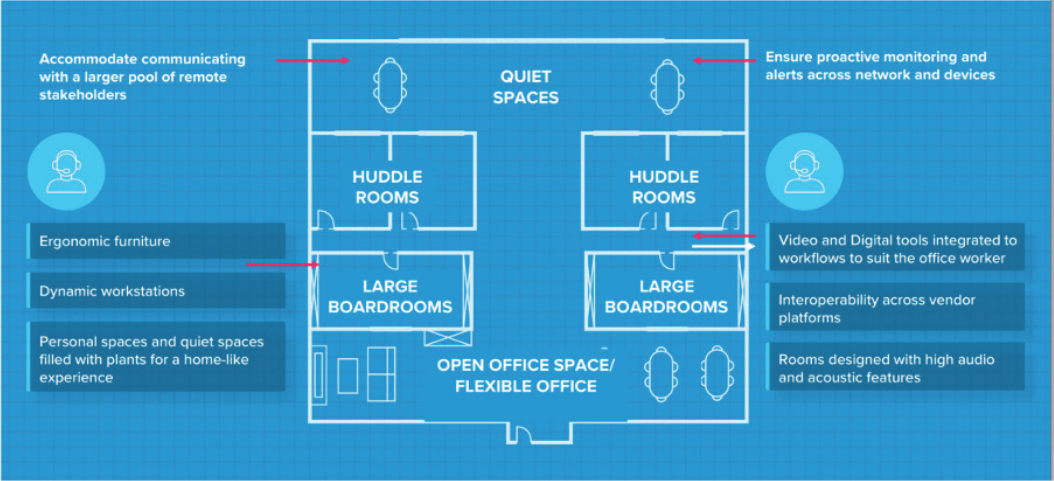
While every organization has differing operational and technology requisites, collaboration spaces, like conference, meeting, and huddle rooms, are at the heart of a successful and thriving hybrid workplace.
Why monitoring is vital to the future workplace
The new hybrid, predominantly digital workplace is complex to say the least. Network issues, problems with devices, video conferencing systems, digital tools and communication platforms are bound to happen.
The new hybrid working ecosystem is constantly evolving. This underscores the need to monitor, as well as gather data and insights so that organizations can prepare for – and quickly respond to – any crises.
There are 4 key considerations that IT leaders need to address:
- Understand which devices are not performing at optimum levels
- Alert the correct people if there are vulnerabilities likely to arise from any platform
- Report statistics like room occupancy and space utilization to meet health and safety protocols
- Ensure that systems are constantly updated to prevent software issues.
People: Creating great experiences
In the hybrid workplace, the most crucial consideration is your people. The success of hybrid working depends on organizations prioritizing their employees and encouraging a stronger, better work-life balance.
Some things employers can look at doing includes:
- Providing your employees with the digital means and support to do their job
- Creating clear rules and best practice guidelines for remote working and virtual meetings
- Allowing employees to flexibly divide their work week between home and office
- Changing the parameters for assessing performance
- Taking steps to ensure that home-based staff don’t feel left out, or isolated
- Focusing on employee wellness and mental health
From a business point of view, organizations with a combination of in-office and remote employees will have a larger talent pool to work with, as they will no longer be confined to hiring employees in specific geographical regions.
A hybrid workplace is also more economical, with less reliance on large scale offices, meaning that organizations can save thousands in real estate and office maintenance costs.
However, in this hybrid model the technology must be front of mind, as the tools you give your employees to do their job from anywhere will define employee experience. It will help drive productivity, attract talent and foster an overall positive workplace culture. Implementing the right technologies and integrating that into workplace design is important.
But the more critical element is ensuring the technology works seamlessly and there is minimal disruption to work. Technology teams must focus on:
- Ensuring that there are minimal interoperability issues as workers choose the workspaces they want to work from
- Managing remote employees’ network and connectivity issues
- Cyber security measures to monitor abnormal behavior patterns
- Allowing employees to use multiple collaboration platforms
What employees are looking for
Ecosystm research has revealed that as many as 33% of employees are looking for a job or career change. To retain talent, and attract new talent, organizations need to pay attention to trends, and listen to what employees want.
Employees are demanding flexibility being a critical component of work. With the Great Resignation a reality, employees will leave if they cannot get the flexibility they want. If organizations neglect to put their employees first, they run the risk of mass dissatisfaction, losing their employees to competition, and the burden of onboarding and retraining new staff – all of which costs money and drains resources.
“(Remote working) is an aberration that we are going to correct as quickly as possible.”
David Solomon, CEO Goldman Sachs
There are generally three categories which sum up employee work expectations in the hybrid workplace.
- Those who wish to work predominantly from home to preserve a better work-life balance.
- Those who are less interested in working remotely 100% of the time, preferring the more flexible hybrid working situation.
- Those who can’t wait to get back to the office full time as they miss the workplace's social aspect and want to escape the fatigue they feel from sitting on endless video calls.
A perfect scenario is when an employee’s expectations align with the needs of the organization, and companies can move ahead with implementing a hybrid work model that easily fits their strategy.
Then, they can begin to put in place the systems, processes and technology needed to benefit from productivity gains and reduced overhead costs.
When employers and employees are not on the same page
So, what happens when employee expectations and those of the organization are vastly different?
Take Goldman Sachs for example, whose CEO David Solomon says, ‘This is not ideal for us, and it’s not a new normal.’ He has called remote working ‘an aberration that we are going to correct as soon as possible’.
Other large corporations like Microsoft, on the other hand, have every intention of implementing permanent hybrid working. Microsoft’s approach embraces the ethos of a hybrid model that works for both employees and the company’s business strategy.
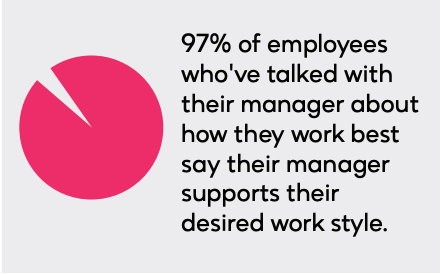
The world’s biggest companies: How much flexibility are they offering employees?
| Company | Flexibility | Sector | Country |
| JP Morgan Chase | little | banking | US |
| Amazon | some | tech & telecoms | US |
| Citigroup | some | banking | US |
| Wells Fargo | some | banking | US |
| Goldman Sachs | little | banking | US |
| Morgan Stanley | little | banking | US |
| HSBC | some | banking | UK |
| NTT | some | tech & telecoms | Japan |
| Unilever | some | retail & consumer | US |
| Capital One Financial | some | banking | US |
| Barclays | some | banking | UK |
| Petrobras | some | energy | Brazil |
Earning the commute
Many employees are rejecting the personal and financial cost of 5-day-a-week commuting after experiencing the convenience and productivity of working remotely.
According to Lendlease Property CEO Kylie Rampa, ‘It’s no longer enough to simply provide a desk and a chair and call it a workplace. Increasingly, employers will need to ‘earn the commute’ of their people’.
Employers will have to work hard to provide compelling reasons for workers to leave their homes to achieve this. The relentless demand for flexibility and talent is challenging employers to reconsider why people come to the office and ask the question ‘what type of work is best done in the office?’
The office as the connector
Social interaction is the one of the main reasons why employees want to return to the office. Many employees have had a hard time separating work and home life while being forced to work remotely. Meeting fatigue and isolation are two of the primary areas of concern for employees.
Adjusting to a remote environment is not just about employees and their families or roommates. It’s also a dramatic change for employers or clients who might not have mastered boundaries and feel it's within their rights to contact workers at any time.
The hybrid work model, where employees spend specific days in the office, can help to define those boundaries more clearly.
Increasingly, hybrid working success will defined by your people and the experience they have within your organization. Putting your people first must be top of mind, so make sure:
- Your strategies are flexible and fit for purpose – be adaptable but be sure to maintain an appropriate level of process and structure.
- You prioritize your people – ensure the tools and technology you have on offer creates a unified experience for all workers, regardless of their role, location, times or where they work.
- You evolve the role of the physical workplace – the office is no longer a place to go to perform tasks; it’s a place to connect and collaborate.
- You rethink workplace culture – this means focusing on the mental and emotional side of work, finding ways to re-invent ‘water cooler’ moments, and involving everyone on some level, no matter where they’re located.
Find out how to create great experiences in the hybrid workplace
Performance: Hybrid work that works — all the time
It’s clear technology has allowed us to collaborate remotely, and it’s technology that will enable the success of the hybrid work model.
But not all collaboration tools are created equally, and when the pandemic first forced workers to leave their posts at the office, many companies chose tools in somewhat of a panic. To stay operational, they had to find ways for employees to collaborate from different locations – and fast.
But now that organizations have become comfortable with the remote working model and transitioned into hybrid working, it’s imperative to implement solutions that work better for everyone in the longer term.
When it comes to collaboration tools, there are key areas of concern for organizations:
- Employees using their own devices and applications
- Lack of a central collaboration tool strategy
- No feedback from employees on what’s working and what isn’t
- Not implementing success metrics
Hybrid working has also introduced a great many variables that affect the performance of collaboration tools and applications. For example, sub-par home internet connections with insufficient bandwidth, security protocol challenges, call quality issues, device incompatibility, and more.
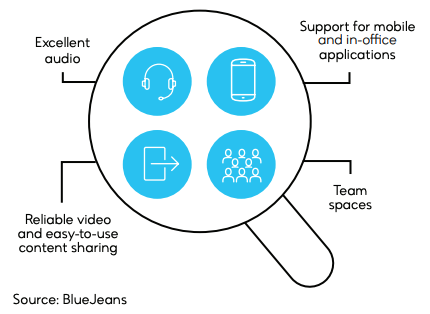
IT and UC teams need data to make informed decisions as to whether the UCaaS tools they implemented, in the beginning, are going to work in the long term. These teams are under more and more pressure to ensure that call quality and overall functionality remain high.
In this section we will take an in-depth look at simplifying the hybrid workplace and ensuring that all collaboration tools, including devices and applications, work as seamlessly as possible.
We’ll look at how employee involvement in creating hybrid strategies can improve the collaborative experience. After all, successful hybrid working can only be possible if all users have a great experience.
Creating a unified experience with tools that work
It would be an understatement to say that IT teams are under an enormous amount of pressure.
With many organizations moving to a multi-vendor UC environment and the challenge of disparate devices and locations, technical staff now need to look in more places to track down the cause of quality and performance issues.
In a multi-vendor environment, OEM analytics software or out-of-the-box solutions can’t communicate with one another. In other words, Cisco’s solutions can’t communicate with Zoom or Microsoft solutions, so in a multi-vendor/hybrid UC setup, finding the root cause of problems is like looking for the proverbial needle in a haystack, so what’s the solution?
An all-seeing eye
Without the ability to take a precise look at the entire UC environment, it will be next to impossible to identify where problems are occurring. Again, this highlights the critical need for third party performance management software that can see everything in your hybrid UC ecosystem.
You can’t fix what you can’t see, and performance issues like glitchy video, poor quality audio, dropped calls, slow upload, and download speed can derail an entire workday – and that translates into lost revenue and poor user satisfaction.
When working from home, what are the biggest frustrations during video meetings?
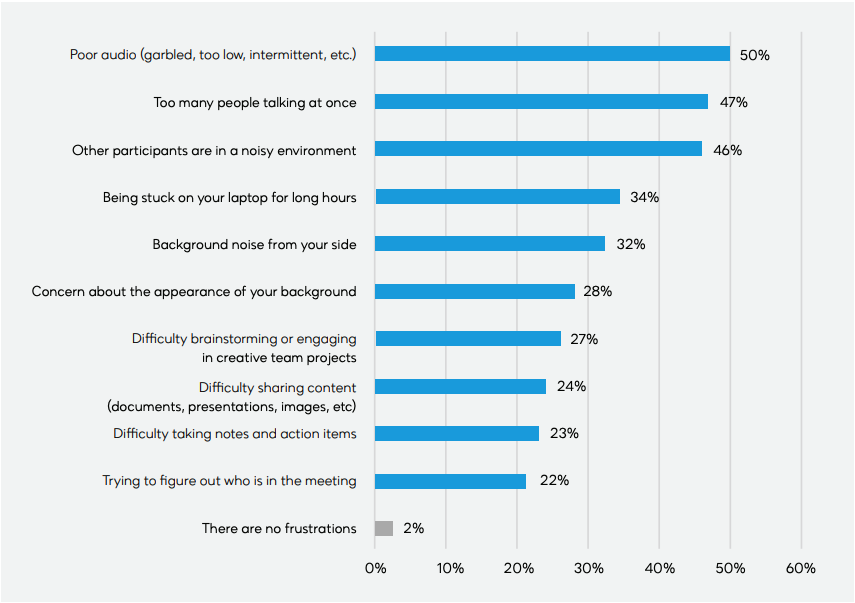
Data and analytics – a goldmine for the hybrid workplace
Meeting the needs and preferences of employees requires using data and monitoring technology to measure performance and experience.
To ensure the hybrid working model can continue seamlessly, the insights gained from collecting data and studying analytics helps organizations to understand where UC systems need attention from a tech point of view.
But data and analytics do much more than that. It can monitor employee performance, identify strengths and weaknesses, levels of satisfaction and engagement with UCaaS applications and much more. These analytics have never been more critical.
Data always tells a story
It’s not enough just to collect data; organizations have to understand it in order to make it work for them.
Harnessing detailed information through analytics gives service providers and enterprises the support and the solutions they need to improve infrastructure, billing, collaboration, and security.
Data is integral to an organization’s successful pivot to hybrid work. Data provides clarity on what is happening, giving leaders crucial insights that result in better, more structured policies.
It reveals customer-support gaps that need closing and guides IT into delivering solutions that materially improve employee experience and maintain productivity and motivation.
Big Data has been around for a long time, but before the advent of cloud services, a significant amount of on-premises computing power was needed to produce necessary analytics. But this has all changed thanks to the advent of performance management software and cloud services.
Facilitating data literacy in the hybrid workplace
Employees need to evolve with an organization’s data strategy in a hybrid world. A data workplace strategy that supports collaborative processes will allow employees to explore real-time data across their departments more deeply and derive value from it in their role.
Regular and persistent training should be set in place so that employees can read, understand, question and challenge data.
Managing performance and experience
A hybrid workplace can help build a crisis-resilient culture by allowing increased freedom, autonomy and flexibility within an organization while maintaining structure. But hybrid working comes with some fundamental flaws from a technical point of view:
Technical issues
- Inconsistent quality of remote network connections
- In-office corporate networks not equipped to handle increased demands of hybrid work, particularly video
- Incompatible devices
- Sub-par audio and video
- Workspaces not optimized for hybrid collaboration – both home workspaces and in-office meeting spaces
- Security risks when faced with managing multiple devices and networks
- The absence of immediate on-site technical support
IT leaders need to simplify complexity and ensure all collaboration tools work seamlessly to succeed in the hybrid workplace. Third-party monitoring solutions can make that happen.
Downtime caused by malfunctioning or underperforming equipment or poor connectivity makes for a frustrating and potentially costly user experience.
The disparate nature of hybrid working means that a UC environment could consist of dozens or even hundreds of different applications, devices, networks and locations.
Third-party monitoring solutions allow you to view metrics, collect essential data, and provide valuable insights and analytics in real-time. This information and the resulting ability to respond to problems immediately can make the difference between a hybrid workplace that works and one that doesn’t.
Collaboration space management
Collaboration spaces, like conference rooms, huddle rooms and breakout spaces, are essential components of modern hybrid workplaces, often bringing together a complex roadmap of in-office teams, remote employees, and external partners and customers.
Hybrid working therefore increases the need for more flexible collaborative spaces outside the typical meeting room. But here’s where things can fall apart quickly.
Successful collaboration relies on quality of sound, connection, and video. You need to understand when and how the tools in your collaboration spaces are being used, in order to most effectively support and manage them, and create a seamless, cohesive collaboration experience for all users.
The best way to achieve this is with proactive monitoring and remote management of all conferencing-enabled collaboration spaces from a single solution.
The role of MSPs and technology partners
As the mandate broadens for tech teams, there are big opportunities for their Managed Service Providers (MSPs) and technology partners. Rapidly evolving technology, combined with a volatile business environment and the pressure to keep IT costs low, are driving strategic alliances between CIOs and MSPs.
The role of MSPs has changed, and they are no longer simply vendors supplying IT services. Today, and particularly in the hybrid working world, MSPs have emerged as a crucial element in running a lean and effective IT organization.
Operating as strategic technology partners, MSPs are executing, automating, securing and scaling IT infrastructure and operations, leaving CIOs and internal IT teams to concentrate on the specifics of helping companies compete in a digital economy.
Organizations today need MSPs for UC and cloud services, implementation of latest technologies and a service management layer, where they ensure that SLAs are being managed effectively.
Here's where MSPs will shine:
|
Experience Testing Experience matters in the new era of work. MSPs have to ensure optimum employee experience across multiple locations. Continual testing to ensure capacity, performance, stability and resilience is an essential capability. |

|
Security The MSP's role is not only to build the right security setup for the enterprise but constantly re-visit security and backups protocols; and proactively monitor any form of threat or vulnerability |
|
Innovation and improvements MSPs must introduce new technologies and best practices along the way, and be an advisor that can help organizations build and improve the Work from Anywhere model as it evolves. |
|
Proactive troubleshooting Hybrid workspaces are increasingly becoming complex - remote access and physical workplaces have their own distinct challenges and issues. The aim should be to preempt and address issues as they arise (or even before) for both remote employees and those working from the office. |
|
Analytics MSPs must be able manage and provide the visibility on UC infrastructure through dashboards and reporting tools. They must ensure that the enterprise infrastructure has the best Quality of Experience (QoE) and Quality of Service (QoS). |
Technology you can rely on
Some organizations are finding it challenging to keep up with a rapidly evolving world of technology.
Some are choosing to overhaul existing IT infrastructures. This can lead to outdated applications and systems that are incompatible or don’t have the agility for the modern hybrid workplace.
Hybrid working has also encouraged many businesses to streamline legacy systems by modernizing and investing in their IT infrastructure from scratch. It’s essential for companies to take stock and review existing systems to ensure they’re fit for purpose.
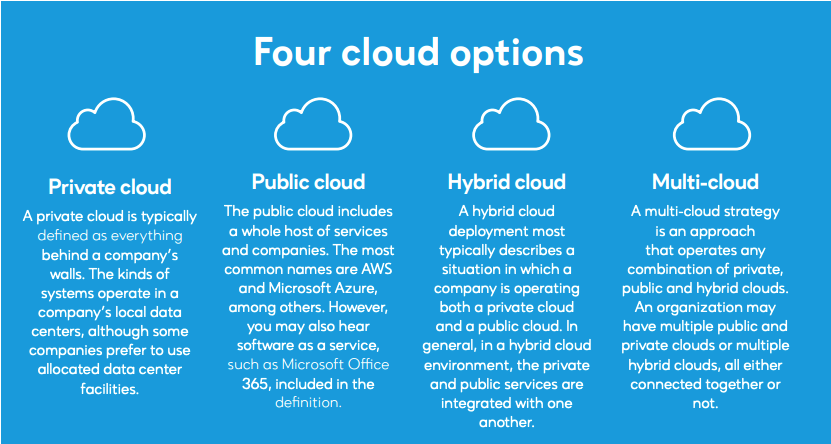 Source: TechTarget
Source: TechTargetThe cloud-based approach
While many businesses were quite familiar with working in the cloud before the pandemic, it is now an integral part of the modern workplace.
As data is stored in an online server, employees can access it from anywhere, at any time, allowing them to do their job no matter where they’re based. This provides the smoothest possible user experience as it facilitates an easy transition between the office and any remote location.
The hybrid cloud model
A hybrid cloud model consists of a mix of public cloud and private cloud components. The public cloud providers host workloads and deliver cloud services to multiple organizations. The private cloud model typically uses on-premises architecture, either in a company's local data center or a separate physical infrastructure provided by a third party. Benefits of a hybrid cloud model include:
- Disaster recovery. A hybrid cloud helps organizations fortify their disaster recovery strategy by replicating on-premises workloads and backing up data in the cloud.
- Development and testing. It’s more efficient and cost-effective to develop and test applications in the public cloud
- Data processing. Hybrid cloud provides the option to use powerful cloud services to run regular analytical queries on locally stored data
- Changing workloads. Hybrid cloud is particularly valuable for dynamic or highly changeable workloads, for example, a transactional order-entry system that experiences significant seasonal demand spikes
Players: How the big collaboration vendors
are future-proofing the hybrid workplace
Hybrid working would not be possible without the tremendous constant output of new solutions from some of the world’s top collaboration giants.
Let’s look at how they’re constantly evolving, innovative offerings are changing the modern workplace.
Microsoft Teams
Microsoft’s approach to hybrid working is to develop a clear strategy that adapts to individual and organizational needs both inside and outside the office. To build a successful hybrid working environment, Microsoft says organizations need to think about three things:
- People – in a successful hybrid organization, empathetic leadership prioritizing individual wellbeing, and encouraging employee skills is vital.
- Process – Both synchronous and asynchronous collaboration are important, and a collaboration platform must encourage connectivity anywhere.
- Place – Microsoft relies on data such as social graphs and employee traffic patterns to ensure that they are working equally in a balanced virtual and physical workspace.
Microsoft Teams has come a long way in the past 2 years and continues to improve and innovate. Some of Microsoft Teams new features take hybrid communication to another level:
- Live Share – lets people interact with content during a meeting. Meeting attendees can work together on a 3-D model, for example. The feature should make meetings more collaborative and interactive.
- Loop – components that can sync across Microsoft 365, for example tables that can stay up to date across documents, presentations, and more.
- Improved discoverability – helping users identify which apps they’re using across different teams and group chats.
- Collaboration controls – Allowing developers to drag and drop Microsoft 365 collaboration features into apps built with Power apps. These include features for Teams chats, meetings, files, and Tasks by Planner.
"Every interaction counts in a video-first world – whether it’s a call with a customer service agent, a video meeting with the sales team, or a hybrid event with customers and prospects. World-class customer engagement is where competitive differentiation happens,”
Oded Gal, Zoom Chief Product Officer
Zoom
During the pandemic, Zoom experienced unprecedented popularity and is now another one of the top collaboration choices for businesses. One of the reasons for its popularity is ease of access and diligently striving to keep latency below 150 milliseconds (the maximum before conversations start to feel unnatural).
Zoom has recently unveiled its latest platform innovations putting engagement at the center of the experience and transforming the way we work, connect, and collaborate.
- Zoom IQ for Sales, a conversation intelligence solution for sales professionals
- New Zoom Events and Webinar functionalities such as backstage and Webinar session branding
Webex by Cisco
Cisco’s ‘5 key Pillars of Successful Hybrid Working’ continue to keep their Webex suite amongst the leading collaboration platforms globally.
- Security
- Manageability
- Flexibility
- Inclusiveness
- Supportiveness
Cisco continues to innovate with new technologies and innovations in enterprise across its networking, security, collaboration and optimized applications portfolio. This is helping organizations drive the productivity, resilience and agility that’s essential in today’s hybrid working world.
Some of Cisco’s new technologies powering an inclusive hybrid future, and delivering unified experiences:
- Cisco has announced new cloud management capabilities that provide a unified experience across Cisco Meraki, Cisco Catalyst and Cisco Nexus portfolios.
- Webex Calling innovations in the new Webex Site to improve work flexibility, reliability, and audio quality. Users no longer risk calls dropping out, despite network outages and broadband bandwidth issues.
- Webex Calling users can now automatically remove background noise from external callers, a new feature that harnesses the Webex Suite’s intelligence capabilities to optimize audio.
- Additionally, Cisco has just launched new devices for hybrid work – The Webex Room Bar and Cisco Video Phone 8875.
Key Takeaways – Delivering a hybrid work model that works
To achieve a thriving and successful hybrid workplace, company leaders need to be aware hybrid working is far more complex than just having some employees in the office and some working from home.
And it’s not just about the collaboration solutions or devices. The successful hybrid workplace strategy takes culture into account and calls upon business leaders to rethink management practices and performance expectations.
A hybrid workplace must also embrace digital transformation, including cloud-native and mobile-first solutions – with collaboration tools as an integral part of the initiative.
Performance management goes hand-in-hand with the success of this initiative.
- There is no one-size-fits-all. Hybrid work is not a one size-fits-all undertaking. Companies should develop strategies where those who work from the office and those who work remotely can be well-equipped to take advantage of all avenues of collaboration at any time.
- Flexibility and agility are vital. Hybrid work depends on flexibility and agility, with leadership that shows direction, enables proactive policies, motivates and builds teams around accountability.
- Collaboration tools need to work. A hybrid workplace relies on tools that work. Monitoring to ensure that those tools work all the time is crucial to the success of today’s working world.
- Employees are the core of a business. Any successful business will consider its employees’ preferences by listening to feedback, involving workers in decision making and fostering a strong company culture.
- The importance of cloud services and the value of MSPs. Cloud services and MSPs are invaluable to a business building a successful hybrid workplace.
Download the Ultimate Guide to Future-Proofing the Hybrid Workplace as a PDF

Download the Ultimate Guide to Future-Proofing the Hybrid Workplace as a PDF




